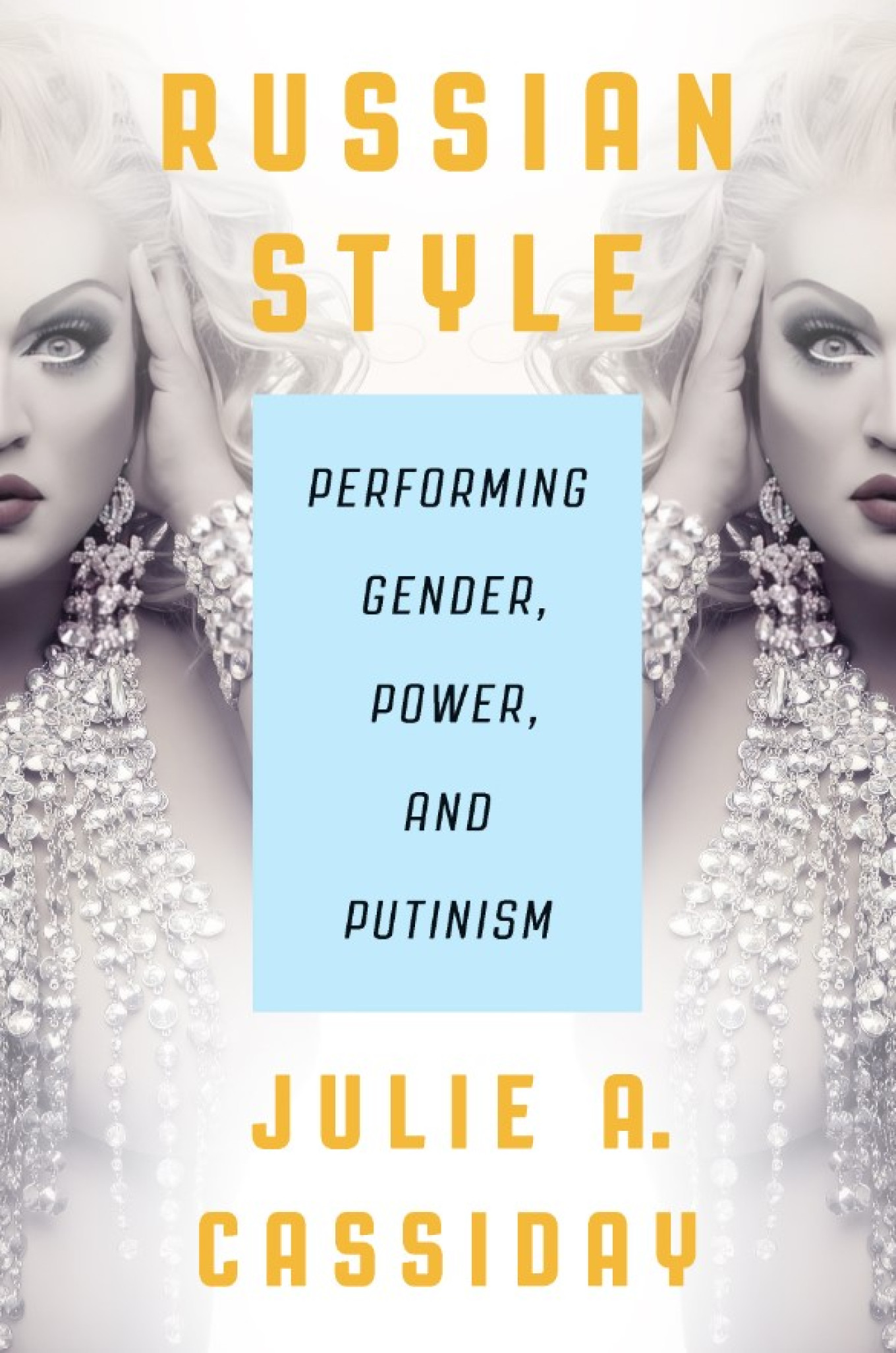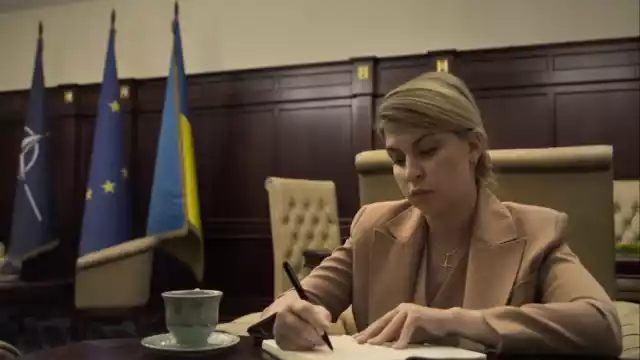At the end of the Soviet era and dawn of Russia’s emergence as a state, the Russian media, and later social media, got very interesting very quickly. It wasn’t only raw politics, revelations about the present and past — it was also sexuality, both “traditional and untraditional,” gay parades and performers, and even a prime time talk show on sex called “About That.” In the early 2000s a new PR team put the new President Putin in photos and videos riding horses topless, diving into the sea for treasures, and putting on other displays of virility and power, seemingly — at the time — to distinguish himself from the previous ailing and hard-drinking leader. These photos and videos were then immediately mocked with memes and jokes that included a particularly famous one of Vladimir Putin as a gay clown and another of him wrapped in a condom like a shawl. All this seemed to be the happy chaotic process of a country coming out of the dusty Soviet closet.
But Julie A. Cassiday, the Willcox B. and Harriet M. Adsit Professor of Russian at Williams College, focuses a more knowledgeable gaze on the Putin era in “Russia Style. Performing Gender, Power, and Putinism.” She analyzes the remarkably wide variety of gender performance by Russia’s citizens — for it is a performance — to reveal the connection with the politics of the new regime. Although it might have seemed that the emphasis on “traditional Orthodox Christian values” — at least the performance of them — was one of the ideological bases of Putinism, Cassiday makes the case that “the primary function of style in Putin’s Russia between 2000 and 2020 was to defer and deflect political substance.”
The Russian styles of the title may not be what you imagine. Plumbing an enormous range of sources — films, television shows, social media, drag shows, self-help books for women, memes, music, YouTube films, the Eurovision song contest and much more — Cassiday defines and tracks how styles of performed gender took the place of ideology under Putin. There are the native styles of poshlost (a mix of vulgarity, falsity, banality and lack of spirituality); stiob (mockery, banter); and glamur (glitzy, showy, glossy faux glamour). Imported styles include charisma — what Putin and his public relations handlers try to perform — camp and kitsch. These styles are not fixed; there is often “slippage,” as when Putin’s macho PR stunts slipped into camp or kitsch, pushed, in part, by the ironic stiob of the early protest movements. The protesters came up with clever mockeries of Putin slogans, such as transforming the campaign phrase “Если не Путин, то кто?” (If not Putin, then who?) with a flip of two letters to make it “Если не Путин, то кот?” (If not Putin, then a cat?). In the end, the most famous stiob, the gay Putin clown image, was banned in 2017.
Although this is not meant to be an encyclopedia of Russian society, Cassiday shows us what we might not have seen even as it was right there, performing in front of us. She takes us back to the traumatic past of the war in Afghanistan through films, into the varied worlds of post-Soviet drag queens (travesti-artisty), from the mystical and spiritual Mamyshev-Monroe to the New Russian Grannies and Ukrainian Andriy Danylko’s iconic Verka Serduchka; to the weirdly competitive world of the Eurovision song contest and performers like tATu and Dima Bilan who perform homoerotism while maintaining heteronormality. Cassiday ends the book with “post-Soviet postfeminism,” which includes “Putin’s Army” — a group of scantily dressed young women who are filmed performing some of the standard moves of porn films (spraying whipping cream in their mouths, washing cars in bikinis) all for their leader —a Russian version of “Fifty Shades of Grey,” prison beauty pageants and a self-help craze called bitchology (стервология) that teaches women how to get anything they want. Throughout all this are performances of what she calls “cis-gender drag,” which we all saw not long ago when Nastya Ivleva — stripped of make-up, hair unstyled, clothes modest — went on camera to apologize for her Naked Party.
The irony of Putin’s project, Cassiday writes, is that the overabundance of Russian style “turned into its opposite – a stylistic vacuum – in the course of just twenty years… in the end they exposed the masculine fragility and male hysteria lurking beneath the glossy surface of Putinism.” The protests against his “masculinity-driven politics“ spurred more protests, which in turn spurred more crackdowns. Putin-the-romantic-lead turned into Putin-the-bully, first in Russia and then in the world. Indeed, as we all saw and Cassiday writes, “…the styles of gender and sexuality fostered by Putinism, which seemed all fun and games in the 2000s and took a turn for the worse in the 2010s, have always been dead serious.”
Russian Style: Performing Gender, Power, and Putinism

From Chapter 3
Travesti and the Post-Soviet Drag Queen
Without doubt, the travesti-artist to enjoy the greatest professional success since the Soviet Union’s demise is Verka Serduchka, the Ukrainian train conductress turned superstar created by Andriy Danylko. Serduchka proves the enduring popularity of the pantomime dame in Russophone pop culture, and her impressive list of achievements, in addition to those already mentioned, includes appearing in some fifteen films and twenty music videos, touring widely in the Former Soviet Union and abroad, and receiving numerous entertainment awards. Serduchka’s performance of “Dancing Lasha Tumbai” on behalf of Ukraine at the 2007 Eurovision Song Contest in Helsinki made her an international pop sensation, reaching far beyond her already sizeable fan base to an estimated 106 million viewers around the world. Her act in Helsinki raised eyebrows not only for its mastery of Eurovision’s camp aesthetic but also and more importantly because of the similarity of the phrase “Lasha Tumbai” (which, the performer claimed, means “whipped cream” in Mongolian) to “Russia Goodbye.” This jab at Ukraine’s neighbor to the north only two years after the Orange Revolution was a risky move at Eurovision, which bans all forms of political expression. Even so, Serduchka’s version of the pantomime dame takes few if any risks with prevailing notions of gender in post-Soviet space despite its clear reliance on gender as a performative construct.
The actual target of Serduchka’s brand of parody comes to light once we consider the relationship of the male actor to his female persona, as well as the type of femininity that pantomime dames like Serduchka choose to adopt more generally. As with Brezhnev-era drag and the New Russian Grannies, Danylko carefully distanced himself from the female persona of Serduchka, and when off stage he wore unambiguously masculine clothing and either avoided discussing his personal life altogether or mentioned past liaisons with women. On stage, Danylko embodied a femininity visibly past its prime and clearly from the lower social strata, which seduced the spectator (if at all) through the overidentification of stiob and strove for neither conventional beauty nor glamour but condescending poshlost’. Furthermore, none of these Soviet and post-Soviet pantomime dames entirely disguised their male bodies beneath the clothing and makeup of drag. In addition to sporting five-o’clock shadows, Mavrikievna and Niktichna simply put headscarves and raincoats over the men’s suits the actors wore on stage. Although the New Russian Grannies expanded this rural anti-chic from head to toe, they similarly eschewed the heavy makeup, wigs, and prosthetic curves for which drag queens are often known. Even Serduchka, who donned glitzy costumes, full drag makeup, and a prosthetic bosom in her heyday, made sure that her femininity missed the mark by typically omitting any suggestion of women’s hair or hips and exaggerating her chest so that no one could miss its falsity. The outsider and abject femininity of Danylko’s act went hand in hand with other indicators of subaltern status, such as Serduchka calling herself “the Ukrainian Cinderella” and using surzhyk, a mixed sociolect of Ukrainian and Russian. In short, Serduchka, like other pantomime dames, aimed not for gender camp, which creates community through fantasies of leveling and inclusion, but for gender kitsch, which discriminates between “us” and “them” via condescension and exclusion. Whatever subversive edge Serduchka’s parody might have had was dulled by misogyny, ageism, classism, and chauvinism. This conservative form of gender parody appealed to viewers and the Russian Federation’s state-sponsored media because it reinforced divisions of sex, age, class, and ethnic identity at the very time it appeared to erase them.
Surprisingly, we find a similar pattern when we look to those travesti-artisty who did not make regular appearances on national television and whose embodiment of femininity aimed not for kitschy poshlost’, but for the height of Putin-era glamour. Given the low profile of most travesti-artisty in traditional media, the internet provided the best access to information about these Russian glamazons. A quick Google search in the early 2010s yielded more than 200,000 hits for the phrase “travesti-artist,” which led me to identify more than one hundred Russian-speaking drag acts based in post-Soviet space at the time. The majority of these performers worked in live theater and nightclubs in a genre of performance called estrada, and they specialized in the drag queen’s stock-in-trade of lip-synching and improvisational comedy, using extravagant makeup and costumes to embody the physical and affective attributes of femininity. Despite the ostensible differences between these travesti-artisty and a pantomime dame like Serduchka, the Russian glamazon provided a striking example of how postfeminism was domesticated in Russia after Putin’s rise to power: using the discourse of labor that Suvi Salmenniemi and Maria Adamson identified in self-help books pitched to Russian women, the Putin-era glamazon performed a clearly constructed and highly sexualized femininity, whose very pretense served to naturalize sexual difference and Russia’s patriarchal gender hierarchy.
This paradoxical transformation of artifice into nature arose from the Russian glamazon’s peculiar discourse of labor, which describes femininity not simply as a matter of work but as the result of professional training and ultimately as an art. The original Russian glamazon, Sergei Zarubin, who performed as Lora Kolli, the reigning diva of the Moscow club scene in the 1990s, epitomized the blend of carefully cultivated theatrical talent and artistic inspiration that secured the drag queen’s superiority to mere biological women and allowed her clearly conventional performance of hyperfemininity to be perceived as authentic. Zarubin’s biography in a book devoted to famous LGBTQ+ Russians stresses his decades of employment in the country’s most prominent theaters, as well as the difference between a travesti-artist and “those for whom women’s dress on stage is merely a realization of their own sexual complexes.” Zarubin describes his decision to perform in drag as a logical step in his development as an actor: “In the West there is no question of who or what you are . . . in the clubs there, ordinary gays come to work; they like to put on [fake] nails [and] to shave their legs and arms so that they look like a woman. There’s some type of pathology in this. For me, Lora Kolli is an opportunity to prove myself professionally. Sexual orientation has nothing to do with it. It’s just that sometimes actors, when they don’t have any roles, start to direct or to write books. So, I created Lora Kolli and started to work, I think, rather successfully as a choreographer.” Zarubin’s insistence that Lora Kolli was not “self-expression” but “work” effectively distanced the travesti-artist from Western drag queens by downplaying the link between drag and the LGBTQ+ community that often provides its most famous performers and ardent fans. Zarubin’s work in Viktiuk’s production of The Maids, his long career in Moscow nightclubs, and his starring role in the original cast of Ruckus in a Henhouse (Perepolokh v golubiatine), a Russian stage adaptation of the 1978 French film La Cage aux Folles, all made him and Lora Kolli fixtures in post-Soviet gay culture. Nonetheless, his claim to an authentic performance of femininity rested on divorcing personal identity from stage persona, much like Danylko.
Zarubin’s emphasis on artistic professionalism also distanced him from pantomime dames like Serduchka, and the most famous Russian glamazons of the 2000s and early 2010s, represented by Aleksandr Peskov, Zaza Napoli, and Anatolii Evdokimov, all echoed this sentiment. All three estrada performers transcended the gender kitsch of the pantomime dame, yet they deployed their male bodies in two distinct manners. While the older Peskov used his slim frame as a hanger on which to drape different feminine and masculine personae, Evdokimov and Napoli used the contours and expressive possibilities of their male bodies to naturalize the distinction between masculine and feminine that they violated, making them models of hyperfemininity for biological women.
Excerpted from “Russian Style: Performing Gender, Power, and Putinism,” written by Julie A. Cassiday and published by The University of Wisconsin Press. Copyright © 2023 The Board of Regents of the University of Wisconsin System. For ease of reading, references have been removed. Used by permission. All rights reserved. For more information about the author and book, see the publisher’s site here.
A Message from The Moscow Times:
Dear readers,
We are facing unprecedented challenges. Russia's Prosecutor General's Office has designated The Moscow Times as an "undesirable" organization, criminalizing our work and putting our staff at risk of prosecution. This follows our earlier unjust labeling as a "foreign agent."
These actions are direct attempts to silence independent journalism in Russia. The authorities claim our work "discredits the decisions of the Russian leadership." We see things differently: we strive to provide accurate, unbiased reporting on Russia.
We, the journalists of The Moscow Times, refuse to be silenced. But to continue our work, we need your help.
Your support, no matter how small, makes a world of difference. If you can, please support us monthly starting from just $2. It's quick to set up, and every contribution makes a significant impact.
By supporting The Moscow Times, you're defending open, independent journalism in the face of repression. Thank you for standing with us.
Remind me later.







